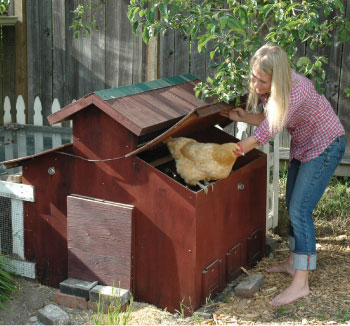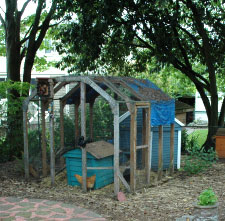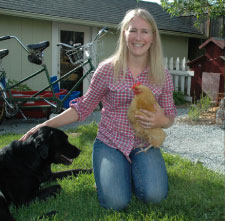City chickens: ruling the roost in urban yards
This article was originally published in July 2010

Seeing eggs stacked in a grocery case, you think about your daily backyard shopping trip to gently scoop eggs from a bed of straw.
Later, you get jostled on a crowded rush-hour bus — but you know that in a few minutes you’ll experience soft feathers rustling in a slow dance around your feet as you scatter feed. There behind your home, beneath the regular rattle of traffic, you hear a rhythmic clucking.
These are the quiet pleasures of the urban chicken keeper, becoming more numerous and visible in Seattle and metro areas around Puget Sound. It’s a trend that might seem entirely at odds with a city lifestyle, but one that delivers simple dividends for the urban farmer who gives up part of the yard to a coop, a run, and a flock of hens.
From yard to farm
“I wanted to bridge the city with the country,” says Ballard resident Ann Fittante, a dietician at Swedish Hospital who was an early fowl adopter and has a hen that’s nearly 10 years old from her first flock. “It’s my way to try to live a simple lifestyle,” she explains.
“We keep chickens mainly because we think they’re great pets and we love their eggs,” says West Seattleite Willi Galloway, a writer for “Organic Gardening” magazine who blogs about food and gardening at her site DigginFood.com. The idea of keeping city chickens, she says, is taking flight. “As people see how easy they are to grow, they think, ‘I can handle that.'”
Both Fittante and Galloway are gardeners, which for many people is another hen connection.
“I suppose we have some cultural memory that chickens are part of a garden,” says Paul Farley of Bainbridge Island, the veteran instructor of Seattle Tilth’s popular chicken-keeping classes. “There are very few families that have to go back more than two or three generations to find poultry-keepers in their family tree.”
Charmaine Slaven didn’t have to go that far. The White Center resident and member of the Tall Boys musical group grew up with chicken chores on the family’s hobby farm in Montana. She got chickens after starting her first Seattle garden. “The chickens added so much,” she says. “They were key to me really starting to compost seriously. I was saving up scraps for them, really paying attention to the waste in my household and where it could go.”
Seeing chickens in the neighborhood made the idea more accessible, says Maggie Anderson, and she decided she could fit it into a busy lifestyle. “I don’t think I have the follow-through to have a dog yet,” she says, “but I could have chickens.” For Anderson, program coordinator for the King County Food & Fitness Initiative at WSU Cooperative Extension, the birds also are a way to “connect ourselves and the people around us to our food.”
The circles are widening, evidenced by public interest. Tilth’s increasing number of classes on chicken-keeping often top out at 50 students, and its annual coop tour, which is coming on July 10, sends hundreds of people to see other urban farming setups. More nurseries are carrying chicken supplies, previously only available at rural feed stores. A national magazine, Backyard Poultry, debuted three years ago.
Slaven met other fowl fanciers in an online “chicken meetup” last spring and they decided to pool resources to buy organic feed. That turned into the Seattle Farm Cooperative, which has “really exploded lately,” and now has more than 500 members. “I feel like maybe we’ve tapped into a quarter or a third of people who have chickens in Seattle,” Slaven says. The group cut the cost of a bag of feed nearly in half from its $30 retail price.
Farley is tapping into the masses too, this year doing a series of 12 talks at King County libraries. The first two drew standing-room-only crowds, he says. “Seven or eight years ago, this level of interest would’ve seemed absurd.”
Keep clucking

Regarding newbies, Slaven and Farley both admit that curiosity exceeds knowledge.
When Farley helps with the hen pens at Tilth’s annual Harvest Fair, people are simply surprised that city chickens are legal, he says. Seattle allows up to three hens on a standard size lot (a proposed revision would raise that to eight) and more if you have more land. Other municipalities allow them, too.
In Tilth classes, Farley routinely gets asked whether you’ll get eggs without having a rooster, because everyone seems to know that city crowing is not okay. (Just to set the record straight, yes, you will get eggs but they will not be fertile, so they couldn’t be hatched.)
Seattle Farm Co-op’s Yahoo group site also gets heavy traffic in “chicken troubleshooting,” says Slaven: “Various chicken biology questions. Home vet care. What to do with chicks that won’t move into the coop.”
The most basic questions, says Farley, are how much will it cost, and how many eggs will I get?
The cost varies widely, primarily based on your architectural aspirations for the coop. You might knock together a hen house in a weekend with salvaged wood and wire, but people could easily spend $600 or much more to have a “chicken palace” built.
To give the girls a “run” for daytime use, you’ll need a well-fenced area. A steady supply of bedding also is needed for coop and run. Again, recycling is possible, using wood chips, sawdust or leaves, but you’ll need a deep, fresh pile to avoid that barnyard odor and that might require buying bedding. Galloway says she adds aspen shavings to her coop twice a month, adds leaves to the run every six weeks, and completely cleans out the coop twice a year.
The investment, of course, does come back literally to feed you, in the form of fresh eggs and possibly, depending on your stomach for such things, meat. You may be able to cut down on your garden fertilizer bill, too. “It’s one of those animals that, once people get around the benefits of them — the free fertilizer, free eggs, free meat — it’s hard to get out of the habit of,” says Slaven.
Some chicken breeds will lay 200 or more eggs a year during their youth. “We have three chickens and get two dozen eggs a week,” says Anderson.
Popular breeds are Rhode Island Red, Barred Rock and Buff Orpington. Less familiar ones are Ameracauna, Maren and Speckled Sussex, which is grown by a Washington state breeder. Usually, feed stores will carry a few standard home breeds, but offer specialized breeds briefly. They also can be mail-ordered. Plumage and egg color — white, brown, blue or green, speckled or not — are often why people choose a breed.

Lifestyle of the urban chicken
Urban chickens aren’t commuters but they might react to the rhythms of the city, Fittante says. “They almost seem to know my work schedule and my days off,” she says. “On the weekends they make more noise.”
It might not take an urban village to raise a flock, but welcoming neighbors certainly will make the project easier. Soothe nerves with eggs every once in a while and practice impeccable coop hygiene to avoid attracting rats.
With chickens, your back yard becomes a mini petting zoo, says Fittante, and “I’m never without a chicken-sitter when I go out of town.” Eggs are usually payment enough.”
Anderson’s Ballard home is next to a city park, and “daily there’s a handful of kids and parents and dogs just sitting there, watching them” and pushing bits of food through the fence. Sometimes, she says, the homeless people who hang out in the park will pay the chickens a visit too. “One said yesterday, ‘I fed the chicken a can of pork and beans,'” she recalls. “We said we’d rather you didn’t.” Chickens can eat kitchen scraps and will enjoy a wide diet, but Farley says they primarily should eat chicken feed.
Anderson’s chickens range freely in the yard, which some people, especially avid gardeners, don’t allow. “They’re hard-wired to scratch,” says Galloway, “it’s not their fault! But in two seconds they can dig stuff up.” They can uproot small perennials and eat the vegetables. “We let them out occasionally,” she admits, “to have really supervised forays into the garden.”
Whether they’re clucking around the yard or in a run, the owner has to anticipate a fair amount of manure. “They poop a lot,” Galloway says with a laugh. “No one tells you that.” When free-ranging, they’d leave droppings on the deck, the chairs, the doormat.
However, letting them “out to pasture” on your grass will mean more flavorful, healthful eggs. Greens help produce eggs higher in omega-3 fatty acids, with deep orange yolks.
When Trouble Arises
The life of an urban chicken is not all petting and snacking, and predators, from dogs to raccoons to coyotes to birds of prey, must be protected against. Proper shelter and sanitation are essential to keep vermin from adopting the coop too, says Don Baxter, enforcement supervisor with the Seattle Animal Shelter. “Put down an appropriate amount of food so they can consume everything” to avoid feeding rats, he advises.
Sturdy fencing must be erected and dug 12 inches into the soil to thwart digging critters. Some people use overhead fencing on their pens for extra safety. And hens must be put into the coop each night for protection against nocturnal animals. Fortunately, chickens sleep in roosts at night, so will readily head to the coop at sunset.
It’s a rare chicken owner, though, who hasn’t experienced a hen escape, and rounding them up, with the help of neighbors and passers-by, becomes another urban chicken experience. Anderson recalls one such episode: “There’s this toothless drunk guy and me and a bunch of neighbors trying to corral these chickens,” she says. She learned that “corralling is about enticing.”
Another possible problem arises if a chicken gets sick. There are a couple of veterinarians who will see your chicken-for a price. Office visits start at $100 and go up steeply. However, “there are essentially no treatments for chickens,” says Farley, “other than palliative care.”
Letting nature take its course with a sick chicken is an urban farming reality. “In some ways it’s good for kids to be around farm animals,” says Slaven. “Dealing with the tragedies with these little creatures in our lives makes us better able to deal with bigger tragedies we face.”
When egg production drops off, as it does in a few years for most breeds, the urban farmer must grapple with the idea of butchering. “On the farm, there’s no room for freeloaders,” says Slaven, who has taught humane slaughter classes for chicken owners. For continual food production, “you’ve got to be able to cull your flock and get fresh chickens.”
“I’m not sure I could actually kill them,” says Galloway. “It’s not just some random chicken, it’s Inky … We’ll just probably have a chicken nursing home.”
Most urban chicken owners won’t slaughter the chickens, Farley says, because they “almost instantly” become pets, with names. “They do clearly respond the way cats and dogs do,” he says. “They recognize you when you bring the food. They talk to you and respond to you.”
In a busy city lifestyle, chickens are becoming the pets with a bonus — they’ll feed you as you feed them. They can enhance a gardener’s ecosystem. And they can serve as a delightful respite from the crowded urban scene, says Anderson. “I appreciate the hearty homecoming when I come into the backyard.”
Bill Thorness is the author of “Edible Heirlooms: Heritage Vegetables for the Maritime Garden.”
